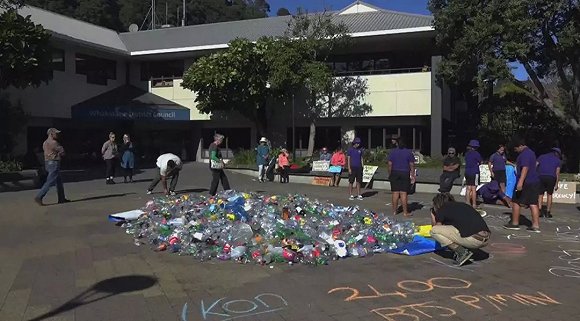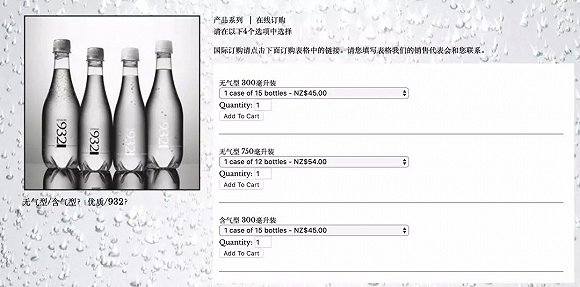The high-end drinking water of Nongfu Spring points to Evian and Paris water, but it encounters resistance from residents of the water source
Interface News, Text | Food Headlines, Li Ke
Editing | Orange
The sales of its own high-end drinking water are not good. In order to "save the country by the curve", Nongfu Spring purchased a water source land in New Zealand. I didn’t expect that as soon as it was excavated, it encountered widespread resistance from the public. In fact, Nongfu Spring is not the only Chinese company targeting the water source in New Zealand. With the "joint efforts" of these companies, New Zealand is in danger of being "hollowed out".
01. Thousands of people "boycotted" Nongfu Spring
On Sunday, residents of the northern New Zealand city of Tauranga held a protest against "foreign-owned enterprises" collecting and bottling water in the local area. People placed more than 2,000 waste plastic bottles on Mt Maunganui Beach and pulled out various banners. The scene was quite spectacular.

Protesters said the campaign was aimed at a series of water extraction operations in New Zealand carried out by Cresswell NZ (hereinafter referred to as: Creswell), a factory owned by the Chinese company Nongfu Spring.
Heidi Hughes, a spokesperson for the protest group, said, "We just wanted to show it to everyone, 2,000 bottles, which is the number of bottles produced per minute at Cresswell’s new Otakiri factory."
However, Cresswell, a subsidiary of Nongfu Spring, immediately denied the claim. Food Jun noticed that Michael Gleissner, managing director of Cresswell, said in an interview with foreign media that the figure was "very exaggerated because the factory does not operate 24 hours a day."
According to public information, in October 2016, Creswell, a wholly-owned New Zealand company owned by Nongfu Spring, was registered; in June last year, Creswell officially purchased the "Otakiri Springs" bottled water factory near Wakatani, North Island, New Zealand. The company’s water source is taken from deep underground, and its products include gas-containing and non-gas, and are available in glass bottles and PET packaging specifications. According to Otakiri’s official website, both gas-containing and non-gas-containing 300ml bottled drinking water are priced at 3 New Zealand dollars (equivalent to about 13 yuan).

At the same time, the New Zealand government approved Cresswell’s expansion plans. Cresswell reportedly plans to build two more bottling plants in nearby Murupara, and hopes to increase groundwater extraction from 2 million litres per year to 580 million litres per year, a 290-fold increase in capacity; to this end, the company intends to buy and lease 6.2 hectares of land in Otakiri.
According to a New Zealand media report, "China’s bottled water giant has been approved by the government to purchase the Bay of Plenty, and the annual extraction capacity exceeds 1 billion liters of drinking water, most of which will be exported to China." According to the data released by foreign media, Creswell’s production capacity will increase by an astonishing 500 times.
Cresswell’s expansion plan will also add extra freight trucks to the area, adding to the pressure on local traffic. "Cresswell’s materials indicate that the plant will have 200 trucking trips a day, which translates to one truck and trailer passing by every three minutes," said Heidi Hughes. "We’re really crowded here already."
More worrying for the local population is the "low-cost plundering" of New Zealand’s water resources by Chinese companies.
Under New Zealand law, freshwater that flows naturally is considered a public good, and "no one has ownership of the water", so water is free. Household water only needs to pay for the maintenance of water pipelines; commercial water such as agriculture and horticulture needs to apply to regional councils for resource permits and pay a nominal fee. Water is usually extracted in daily or annual rations, with flow caps attached.
It is worth noting that because New Zealand’s water is a public good, it doesn’t cost money to pump it into mineral water and export it to other countries.
The latest poll by New Zealand research agency Newshub-ReidResearch shows that 87% of New Zealanders are unhappy that exporters get water almost free and then export it abroad for a large profit.
In the face of various "doubts", the official of Nongfu Spring insists that the exploitation of local water resources is reasonable.
"There is an error in the description of the amount of extraction in the above foreign media reports. The total amount applied by Nongfu Spring does not exceed 1.10 million tons per year. The local groundwater resources are abundant, and 35% of the total amount can be used for water extraction; while the maximum amount applied by Nongfu Spring only accounts for 4.9% of this 35%, which will not affect the local groundwater. This amount of extraction is a normal and reasonable amount for a large-scale bottled water production plant, and it can completely maintain sustainable development." Zhou Li, secretary of the board of directors of Nongfu Spring joint stock company, told Food Jun.
02. High-end is not conducive to overseas "learning from experience"
In recent years, Nongfu Spring, China’s largest producer of bottled water, has targeted the New Zealand market. The New Zealand government has also "welcomed Nongfu Spring". For example, the New Zealand Trade Development Agency has provided significant assistance to China’s Nongfu Spring Company to enter the New Zealand market.
In August 2015, after receiving the invitation of the New Zealand Trade Development Bureau, the senior management of Nongfu Spring officially went to New Zealand. What attracted the attention of the outside world was that Zhong Shanxuan, the head of Nongfu Spring, also came to New Zealand, which was enough to prove the attractiveness of the New Zealand market to Nongfu Spring. The Otakiri Springs bottled water factory was favored by Nongfu Spring’s senior management at that time, and the Nongfu Spring delegation even took samples of bottled water produced locally and brought them back to China.
In April 2016, during a visit to China, New Zealand Prime Minister John Key met with 10 Chinese entrepreneurs in Shanghai, among whom Zhong was one, and the two discussed Nongfu Spring’s investment in New Zealand.
Documents released under the Official Information Act show that officials at the trade development agency are not only nominally supportive of Nongfu Spring, but also involved in many specific processes. Under the arrangement of the trade development agency, the New Zealand authorities approached Nongfu Spring and listed suitable water plants for acquisition. In total, the trade development agency has offered Nongfu Spring five potential acquisition targets. Two of them are ready-made bottled water plants, and the remaining three are also promising.